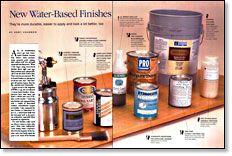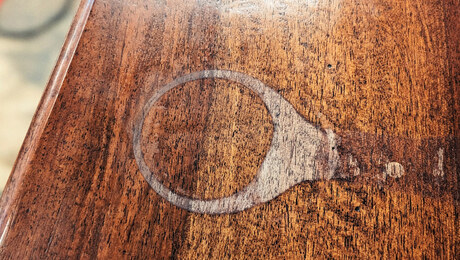New Water-Based Finishes
They're more durable, easier to apply and look a lot better, too
Synopsis: Andy Charron notes how water-based finishes have improved over the years and compares nine to a few tried-and true finishes. The ones he tested scored well on stain resistance, and grain raising wasn’t objectionable. They were all tested on mahogany plywood, and he evaluated their adhesion over oil-based stain, stain resistance, heat resistance, raised grain, sanding, best applicator, and appearance. For example, in testing adhesion over an oil-based stain, the author sliced into the finish with a utility knife, pressed packing tape over the cut, and waited five minutes. Then the tape was removed. See what Charron thought of the finishes overall and which performed best. Side information gives ways to improve the appearance of water-based finishes by tinting the wood or coloring the topcoat using pigments, water-soluble dyes, or alcohol dyes.
A lot of woodworkers won’t get near waterbased finishes because they believe these products cause excessive grain raising, don’t adhere well over oil-based stains and look like plastic. When I first began using water-based finishes about eight years ago. these products were indeed difficult to use and didn’t look so hot. That’s not the case anymore. Water-based finishes are getting better all the time. Also, they don’t give off noxious fumes, they dry fast, and they aren’t flammable.
A prior survey in the magazine evaluated 15 water-based finishes. Manufacturers have been busy, and there’s a whole new crop of finishes on the market. I tried nine new finishes and compared them with a couple of time-tested finishes: nitrocellulose lacquer and shellac. I also compared the new finishes to Famowood Super Lac, a water-based finish that did extremely well in the previous evaluation, especially when measured on appearance.
The new finishes really stand out when it comes to stain resistance. Most were bulletproof Grain raising wasn’t objectionable with the majority of the finishes, and a few barely raised the grain at all. Some of the finishes were difficult to apply, although most went on without a hitch.
Rating the products on appearance is the most subjective test, but an important one, and several finishes scored very high. Even the finishes that scored low on appearance are light-years ahead of what I was using five years ago. It’s fair to say that waterbased finishes are getting better, and I imagine the trend will continue.
Resins and additives have been improved
Traditional finishes such as lacquer and shellac have very few ingredients, primarily resins (solids that form the finish film) and solvents (also called carriers), which dissolve the resins. Water-based finishes are similar in that they, too, contain resins and solvents. But water-based finishes have many more additives than traditional lacquers, sometimes as many as 20, to deal with the basic incompatibility of water and resin. The other chemicals, especially ones called surfactants, allow water and resins to mix together, forming an emulsion. As the water evaporates, alcohols or cosolvents soften the resins, allowing them to coalesce and form the finish film.
From Fine Woodworking #133
For the full article, download the PDF below:
Fine Woodworking Recommended Products

Veritas Wheel Marking Gauge

Tite-Mark Marking Gauge

Bahco 6-Inch Card Scraper





















Log in or create an account to post a comment.
Sign up Log in